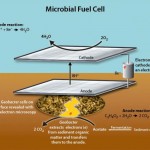 Diagram of a microbial fuel cell that runs on acetate, one half of the bacterial battery described here. (credit: Oak Ridge National Lab ) The chemical that powers most of our cellular processes is produced through something called the electron transport chain. As its name suggests, this system shuffles electrons through a series of chemicals that leaves them at a lower energy, all while harvesting some of the energy difference to produce ATP. But the ultimate destination of this electron transport chain doesn’t have to be a chemical. There are a variety of bacteria that ultimately send the electrons off into the environment instead. And researchers have figured out how to turn these into a fuel cell, harvesting the electrons to do something useful. While some of these designs were closer to a battery than others, all of them consumed some sort of material in harvesting the electrons. A team of researchers in the Netherlands figured out how to close the loop and create an actual bacterial battery. One half of the battery behaves like a bacterial fuel cell. But the second half takes the electrons and uses them to synthesize a small organic molecule that the first can eat. Its charging cycle is painfully slow and its energy density is atrocious, but the fact that it works at all seems rather noteworthy. Read 11 remaining paragraphs | Comments
Diagram of a microbial fuel cell that runs on acetate, one half of the bacterial battery described here. (credit: Oak Ridge National Lab ) The chemical that powers most of our cellular processes is produced through something called the electron transport chain. As its name suggests, this system shuffles electrons through a series of chemicals that leaves them at a lower energy, all while harvesting some of the energy difference to produce ATP. But the ultimate destination of this electron transport chain doesn’t have to be a chemical. There are a variety of bacteria that ultimately send the electrons off into the environment instead. And researchers have figured out how to turn these into a fuel cell, harvesting the electrons to do something useful. While some of these designs were closer to a battery than others, all of them consumed some sort of material in harvesting the electrons. A team of researchers in the Netherlands figured out how to close the loop and create an actual bacterial battery. One half of the battery behaves like a bacterial fuel cell. But the second half takes the electrons and uses them to synthesize a small organic molecule that the first can eat. Its charging cycle is painfully slow and its energy density is atrocious, but the fact that it works at all seems rather noteworthy. Read 11 remaining paragraphs | Comments
Read More:
All-bacterial battery makes a nutrient when charged, eats it to discharge





